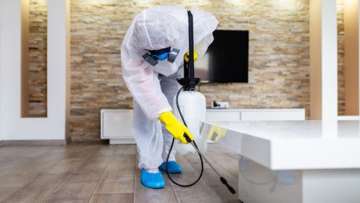Cleaning or disinfecting areas we live in or work is extremely essential in the time of coronavirus. Disinfecting, which is an advance form of sanitizing is important to reduce the potential risk of COVID-19 contamination to your loved ones. Sanitizing your home or workplace is important to keep yourself healthy and fit. Person-to-person transmission of coronavirus is more likely than from surface so you must use your face mask hand sanitisers as an ultimate precaution in addition to cleaning of your homes. To kill virus or bacteria we must be disinfecting our homes thoroughly to reduce chances of surface-to-surface transmission.
Most of us use an alcohol-based sanitizer spray to disinfect our homes from germs, viruses and bacterias. But are you sure you are doing things right? Have you checked if the disinfectant or sanitizer you are using does the required job?
There have been instances when these disinfectants, that have swamped our markets and localities, are diluted, putting us at risk. Also, it is important to know whether things you have been doing to disinfect is the right way or not.
According to the World Health Organisation (WHO), we need to prioritise areas for disinfection and know how to disinfect
1. High Touch Areas
High-touch surfaces in should be identified for priority disinfection such as door and window handles, kitchen and food preparation areas, countertops, bathroom surfaces, toilets and taps, touchscreen personal devices, personal computer keyboards, and work surfaces.
2. What kind of disinfectants you should use?
A diluted disinfectant or sanitizer puts your life at risk. For non-healthcare settings, WHO recommends the following as disinfectants:
Sodium hypochlorite (bleach/chlorine) may be used at a recommended concentration of 0.1% or 1,000ppm (1 part of 5% strength household bleach to 49 parts of water).
Alcohol at 70-90% can also be used for surface disinfection.
3. How to clean or disinfect?
You must clean surfaces with water and soap or detergent first to remove dirt, followed by disinfection.
Cleaning should always start from the least soiled (cleanest) area to the most soiled (dirtiest) area to not spread the dirty to less soiled areas.
4. Avoid spraying
In indoor spaces, applying disinfectants to surfaces via spraying is not recommended for COVID-19. If disinfectants are to be applied, these should be via a cloth or wipe which is soaked in the disinfectant, as per WHO recommendations.
5. Common mistakes you must avoid while sanitizing
- Do not keep the windows and doors of your house closed while sanitization
- Open windows and use fans to ventilate.
- Step away from odours if they become too strong. Disinfectant solutions should always be prepared in well-ventilated areas.
- Avoid combining disinfectants, such as bleach and ammonia, since mixtures can cause respiratory irritation and release potentially fatal gases.
- Keep lids tightly closed when not in use. Spills and accidents are more likely to happen when containers are open.
-Do not allow children to use disinfectant wipes. Keep cleaning fluids and disinfectants out of the reach of children and pets.
- Throw away disposable items like gloves and masks if they are used during cleaning. Do not clean and re-use.
-Do not use disinfectant wipes to clean hands or as baby wipes
- Wear rubber gloves, waterproof aprons and closed shoes while sanitizing your house.
Note: Frequent hand washing and avoiding touching the face should be the primary prevention approaches to reduce any potential transmission associated with surface contamination.
